Analyzing Organizational Culture's Impact on Sainsbury's Employees
VerifiedAdded on 2022/11/29
|9
|2500
|276
Thesis and Dissertation
AI Summary
This dissertation, focused on Sainsbury's, a major UK retail chain, investigates the influence of organizational culture on employee performance. The study begins with an introduction outlining the background, aim, objectives, research questions, rationale, and significance of the research, followed by the structure of the dissertation. Chapter 2 provides a literature review, exploring key themes and theories related to organizational culture, including its impact on employee behavior, productivity, and the importance of leadership. The research aims to understand the concept of organizational culture, identify factors affecting Sainsbury's internal culture, determine the relationship between culture and employee performance, and recommend improvements. The dissertation emphasizes the importance of a positive working environment and its effects on both financial and non-financial aspects of the organization, highlighting the need for organizations to carefully manage their culture to avoid negative impacts on employee performance. The structure of the dissertation continues to include a discussion on research methodology, data analysis, and conclusions with recommendations. The literature review examines various models of organizational culture, including clan, holacratic, meritocracies, Denison, and adhocracy, and it stresses the role of leaders in maintaining and shaping organizational culture.
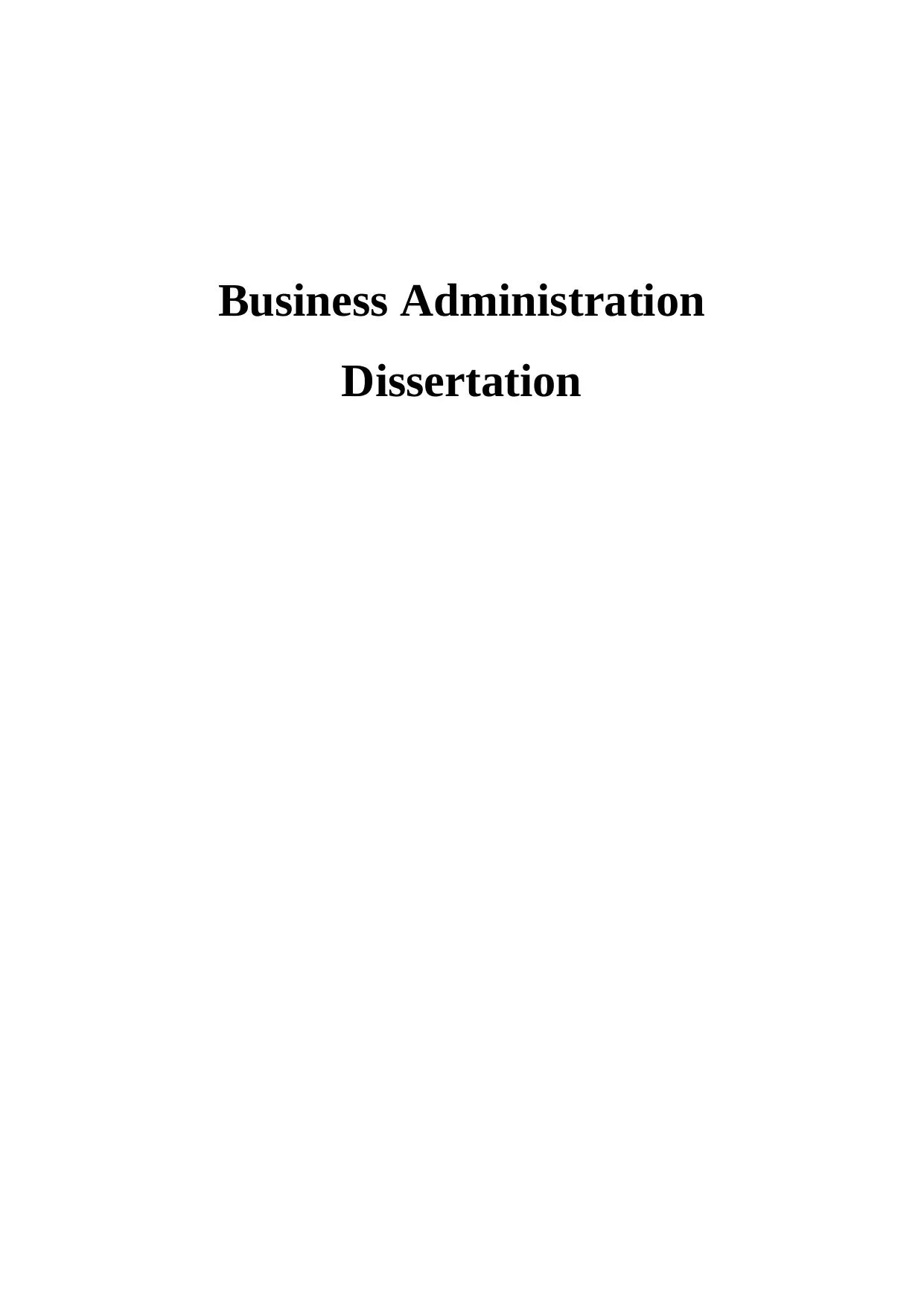
Business Administration
Dissertation
Dissertation
Paraphrase This Document
Need a fresh take? Get an instant paraphrase of this document with our AI Paraphraser
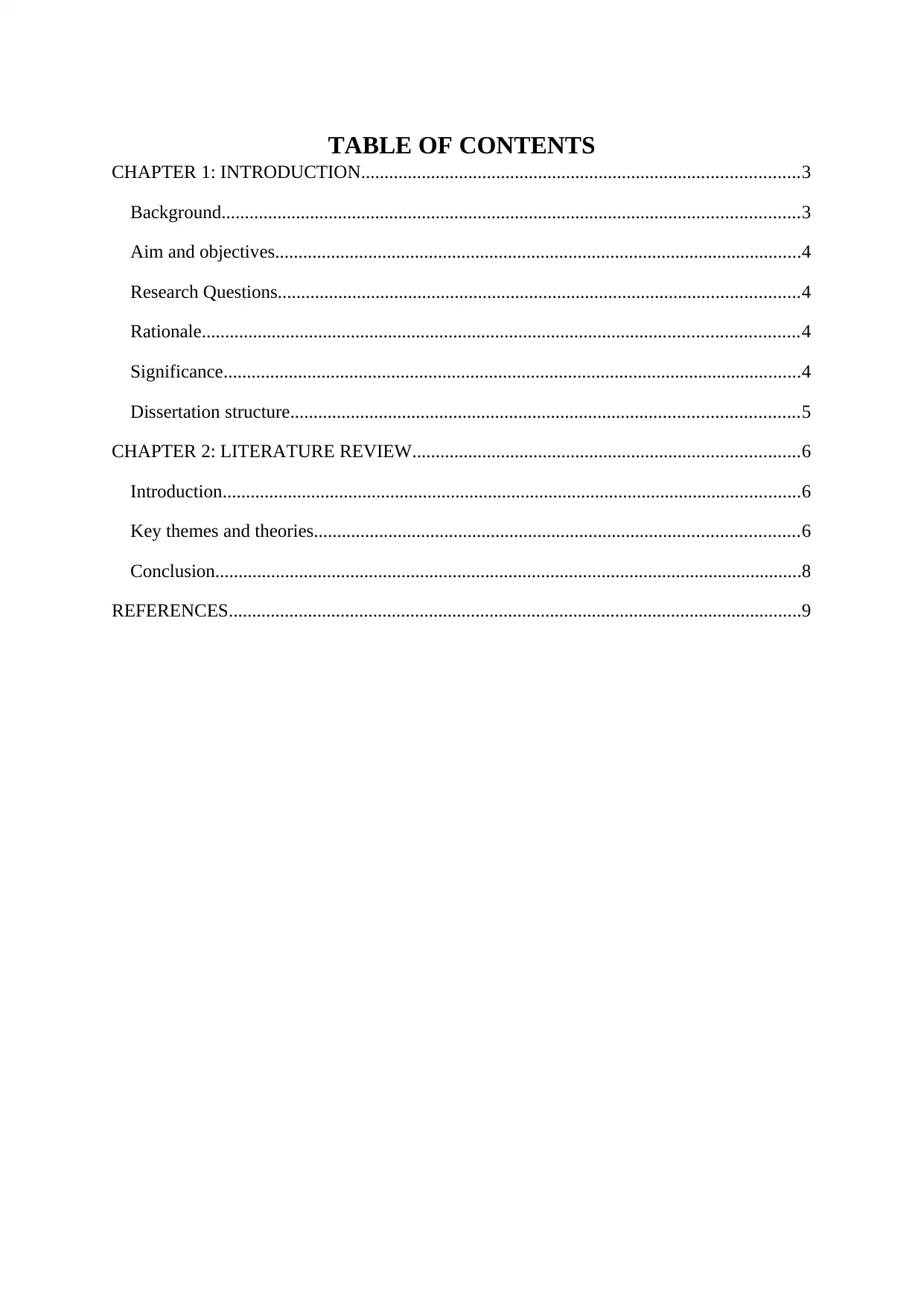
TABLE OF CONTENTS
CHAPTER 1: INTRODUCTION..............................................................................................3
Background............................................................................................................................3
Aim and objectives.................................................................................................................4
Research Questions................................................................................................................4
Rationale................................................................................................................................4
Significance............................................................................................................................4
Dissertation structure.............................................................................................................5
CHAPTER 2: LITERATURE REVIEW...................................................................................6
Introduction............................................................................................................................6
Key themes and theories........................................................................................................6
Conclusion..............................................................................................................................8
REFERENCES...........................................................................................................................9
CHAPTER 1: INTRODUCTION..............................................................................................3
Background............................................................................................................................3
Aim and objectives.................................................................................................................4
Research Questions................................................................................................................4
Rationale................................................................................................................................4
Significance............................................................................................................................4
Dissertation structure.............................................................................................................5
CHAPTER 2: LITERATURE REVIEW...................................................................................6
Introduction............................................................................................................................6
Key themes and theories........................................................................................................6
Conclusion..............................................................................................................................8
REFERENCES...........................................................................................................................9
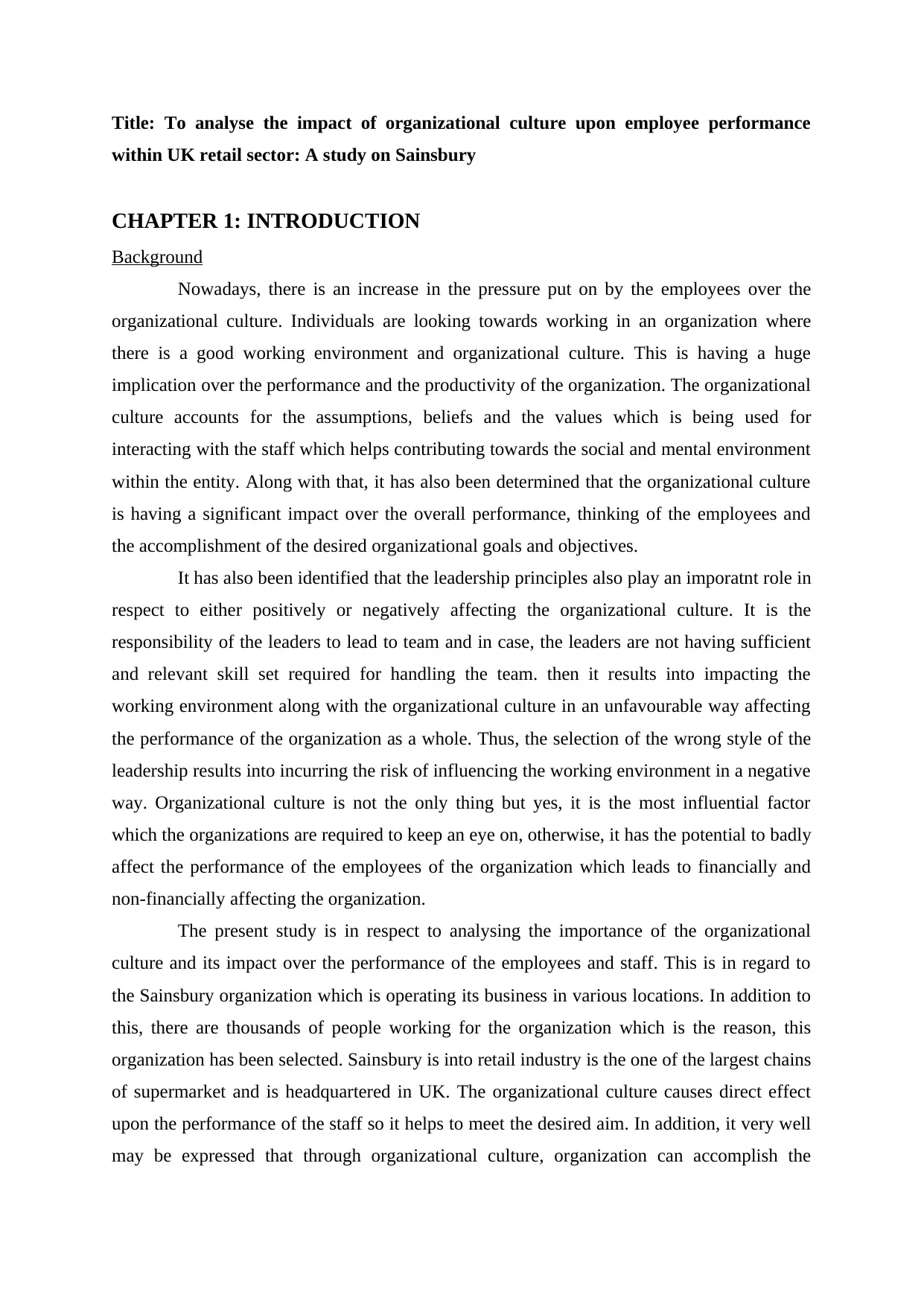
Title: To analyse the impact of organizational culture upon employee performance
within UK retail sector: A study on Sainsbury
CHAPTER 1: INTRODUCTION
Background
Nowadays, there is an increase in the pressure put on by the employees over the
organizational culture. Individuals are looking towards working in an organization where
there is a good working environment and organizational culture. This is having a huge
implication over the performance and the productivity of the organization. The organizational
culture accounts for the assumptions, beliefs and the values which is being used for
interacting with the staff which helps contributing towards the social and mental environment
within the entity. Along with that, it has also been determined that the organizational culture
is having a significant impact over the overall performance, thinking of the employees and
the accomplishment of the desired organizational goals and objectives.
It has also been identified that the leadership principles also play an imporatnt role in
respect to either positively or negatively affecting the organizational culture. It is the
responsibility of the leaders to lead to team and in case, the leaders are not having sufficient
and relevant skill set required for handling the team. then it results into impacting the
working environment along with the organizational culture in an unfavourable way affecting
the performance of the organization as a whole. Thus, the selection of the wrong style of the
leadership results into incurring the risk of influencing the working environment in a negative
way. Organizational culture is not the only thing but yes, it is the most influential factor
which the organizations are required to keep an eye on, otherwise, it has the potential to badly
affect the performance of the employees of the organization which leads to financially and
non-financially affecting the organization.
The present study is in respect to analysing the importance of the organizational
culture and its impact over the performance of the employees and staff. This is in regard to
the Sainsbury organization which is operating its business in various locations. In addition to
this, there are thousands of people working for the organization which is the reason, this
organization has been selected. Sainsbury is into retail industry is the one of the largest chains
of supermarket and is headquartered in UK. The organizational culture causes direct effect
upon the performance of the staff so it helps to meet the desired aim. In addition, it very well
may be expressed that through organizational culture, organization can accomplish the
within UK retail sector: A study on Sainsbury
CHAPTER 1: INTRODUCTION
Background
Nowadays, there is an increase in the pressure put on by the employees over the
organizational culture. Individuals are looking towards working in an organization where
there is a good working environment and organizational culture. This is having a huge
implication over the performance and the productivity of the organization. The organizational
culture accounts for the assumptions, beliefs and the values which is being used for
interacting with the staff which helps contributing towards the social and mental environment
within the entity. Along with that, it has also been determined that the organizational culture
is having a significant impact over the overall performance, thinking of the employees and
the accomplishment of the desired organizational goals and objectives.
It has also been identified that the leadership principles also play an imporatnt role in
respect to either positively or negatively affecting the organizational culture. It is the
responsibility of the leaders to lead to team and in case, the leaders are not having sufficient
and relevant skill set required for handling the team. then it results into impacting the
working environment along with the organizational culture in an unfavourable way affecting
the performance of the organization as a whole. Thus, the selection of the wrong style of the
leadership results into incurring the risk of influencing the working environment in a negative
way. Organizational culture is not the only thing but yes, it is the most influential factor
which the organizations are required to keep an eye on, otherwise, it has the potential to badly
affect the performance of the employees of the organization which leads to financially and
non-financially affecting the organization.
The present study is in respect to analysing the importance of the organizational
culture and its impact over the performance of the employees and staff. This is in regard to
the Sainsbury organization which is operating its business in various locations. In addition to
this, there are thousands of people working for the organization which is the reason, this
organization has been selected. Sainsbury is into retail industry is the one of the largest chains
of supermarket and is headquartered in UK. The organizational culture causes direct effect
upon the performance of the staff so it helps to meet the desired aim. In addition, it very well
may be expressed that through organizational culture, organization can accomplish the
⊘ This is a preview!⊘
Do you want full access?
Subscribe today to unlock all pages.

Trusted by 1+ million students worldwide
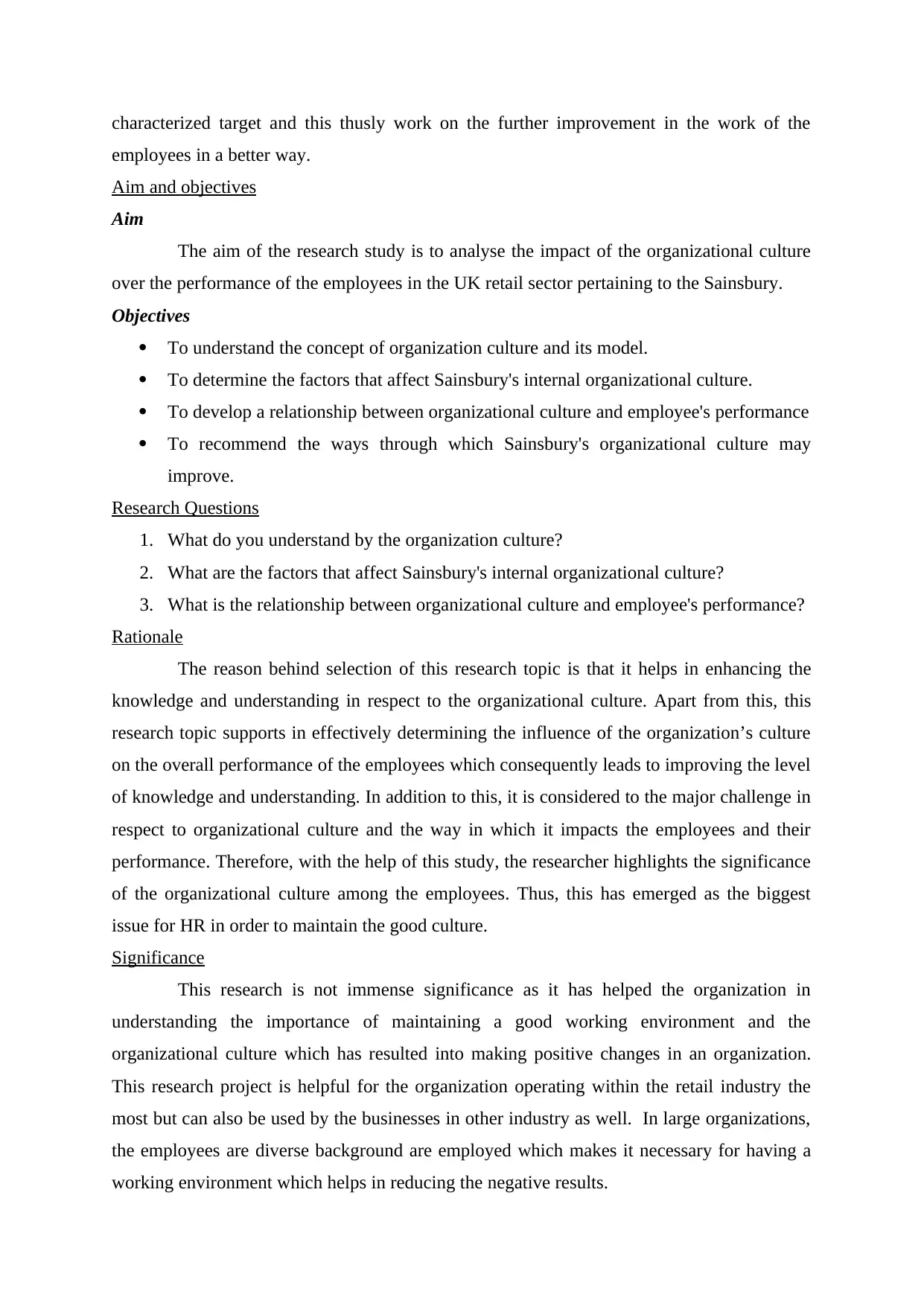
characterized target and this thusly work on the further improvement in the work of the
employees in a better way.
Aim and objectives
Aim
The aim of the research study is to analyse the impact of the organizational culture
over the performance of the employees in the UK retail sector pertaining to the Sainsbury.
Objectives
To understand the concept of organization culture and its model.
To determine the factors that affect Sainsbury's internal organizational culture.
To develop a relationship between organizational culture and employee's performance
To recommend the ways through which Sainsbury's organizational culture may
improve.
Research Questions
1. What do you understand by the organization culture?
2. What are the factors that affect Sainsbury's internal organizational culture?
3. What is the relationship between organizational culture and employee's performance?
Rationale
The reason behind selection of this research topic is that it helps in enhancing the
knowledge and understanding in respect to the organizational culture. Apart from this, this
research topic supports in effectively determining the influence of the organization’s culture
on the overall performance of the employees which consequently leads to improving the level
of knowledge and understanding. In addition to this, it is considered to the major challenge in
respect to organizational culture and the way in which it impacts the employees and their
performance. Therefore, with the help of this study, the researcher highlights the significance
of the organizational culture among the employees. Thus, this has emerged as the biggest
issue for HR in order to maintain the good culture.
Significance
This research is not immense significance as it has helped the organization in
understanding the importance of maintaining a good working environment and the
organizational culture which has resulted into making positive changes in an organization.
This research project is helpful for the organization operating within the retail industry the
most but can also be used by the businesses in other industry as well. In large organizations,
the employees are diverse background are employed which makes it necessary for having a
working environment which helps in reducing the negative results.
employees in a better way.
Aim and objectives
Aim
The aim of the research study is to analyse the impact of the organizational culture
over the performance of the employees in the UK retail sector pertaining to the Sainsbury.
Objectives
To understand the concept of organization culture and its model.
To determine the factors that affect Sainsbury's internal organizational culture.
To develop a relationship between organizational culture and employee's performance
To recommend the ways through which Sainsbury's organizational culture may
improve.
Research Questions
1. What do you understand by the organization culture?
2. What are the factors that affect Sainsbury's internal organizational culture?
3. What is the relationship between organizational culture and employee's performance?
Rationale
The reason behind selection of this research topic is that it helps in enhancing the
knowledge and understanding in respect to the organizational culture. Apart from this, this
research topic supports in effectively determining the influence of the organization’s culture
on the overall performance of the employees which consequently leads to improving the level
of knowledge and understanding. In addition to this, it is considered to the major challenge in
respect to organizational culture and the way in which it impacts the employees and their
performance. Therefore, with the help of this study, the researcher highlights the significance
of the organizational culture among the employees. Thus, this has emerged as the biggest
issue for HR in order to maintain the good culture.
Significance
This research is not immense significance as it has helped the organization in
understanding the importance of maintaining a good working environment and the
organizational culture which has resulted into making positive changes in an organization.
This research project is helpful for the organization operating within the retail industry the
most but can also be used by the businesses in other industry as well. In large organizations,
the employees are diverse background are employed which makes it necessary for having a
working environment which helps in reducing the negative results.
Paraphrase This Document
Need a fresh take? Get an instant paraphrase of this document with our AI Paraphraser
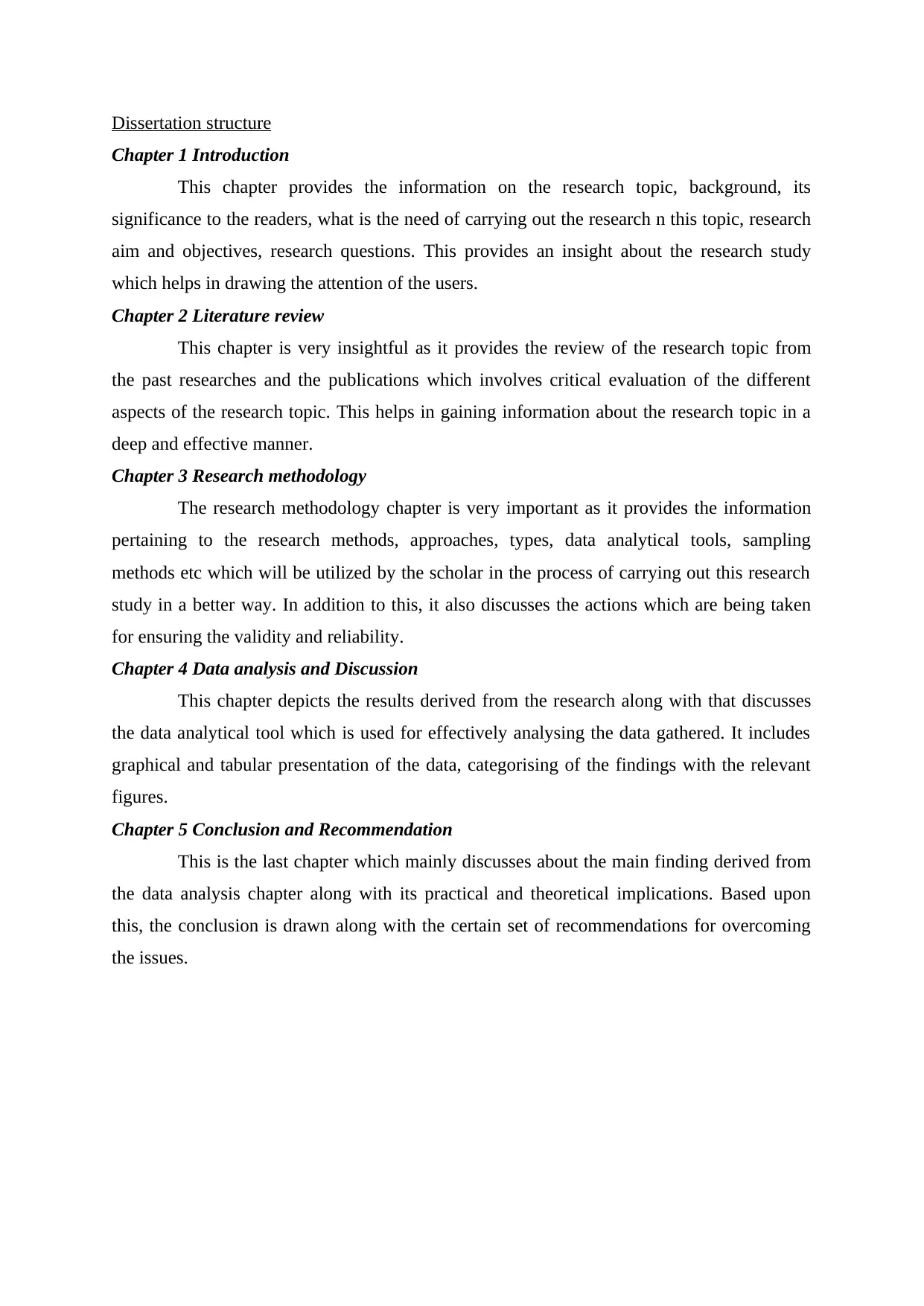
Dissertation structure
Chapter 1 Introduction
This chapter provides the information on the research topic, background, its
significance to the readers, what is the need of carrying out the research n this topic, research
aim and objectives, research questions. This provides an insight about the research study
which helps in drawing the attention of the users.
Chapter 2 Literature review
This chapter is very insightful as it provides the review of the research topic from
the past researches and the publications which involves critical evaluation of the different
aspects of the research topic. This helps in gaining information about the research topic in a
deep and effective manner.
Chapter 3 Research methodology
The research methodology chapter is very important as it provides the information
pertaining to the research methods, approaches, types, data analytical tools, sampling
methods etc which will be utilized by the scholar in the process of carrying out this research
study in a better way. In addition to this, it also discusses the actions which are being taken
for ensuring the validity and reliability.
Chapter 4 Data analysis and Discussion
This chapter depicts the results derived from the research along with that discusses
the data analytical tool which is used for effectively analysing the data gathered. It includes
graphical and tabular presentation of the data, categorising of the findings with the relevant
figures.
Chapter 5 Conclusion and Recommendation
This is the last chapter which mainly discusses about the main finding derived from
the data analysis chapter along with its practical and theoretical implications. Based upon
this, the conclusion is drawn along with the certain set of recommendations for overcoming
the issues.
Chapter 1 Introduction
This chapter provides the information on the research topic, background, its
significance to the readers, what is the need of carrying out the research n this topic, research
aim and objectives, research questions. This provides an insight about the research study
which helps in drawing the attention of the users.
Chapter 2 Literature review
This chapter is very insightful as it provides the review of the research topic from
the past researches and the publications which involves critical evaluation of the different
aspects of the research topic. This helps in gaining information about the research topic in a
deep and effective manner.
Chapter 3 Research methodology
The research methodology chapter is very important as it provides the information
pertaining to the research methods, approaches, types, data analytical tools, sampling
methods etc which will be utilized by the scholar in the process of carrying out this research
study in a better way. In addition to this, it also discusses the actions which are being taken
for ensuring the validity and reliability.
Chapter 4 Data analysis and Discussion
This chapter depicts the results derived from the research along with that discusses
the data analytical tool which is used for effectively analysing the data gathered. It includes
graphical and tabular presentation of the data, categorising of the findings with the relevant
figures.
Chapter 5 Conclusion and Recommendation
This is the last chapter which mainly discusses about the main finding derived from
the data analysis chapter along with its practical and theoretical implications. Based upon
this, the conclusion is drawn along with the certain set of recommendations for overcoming
the issues.
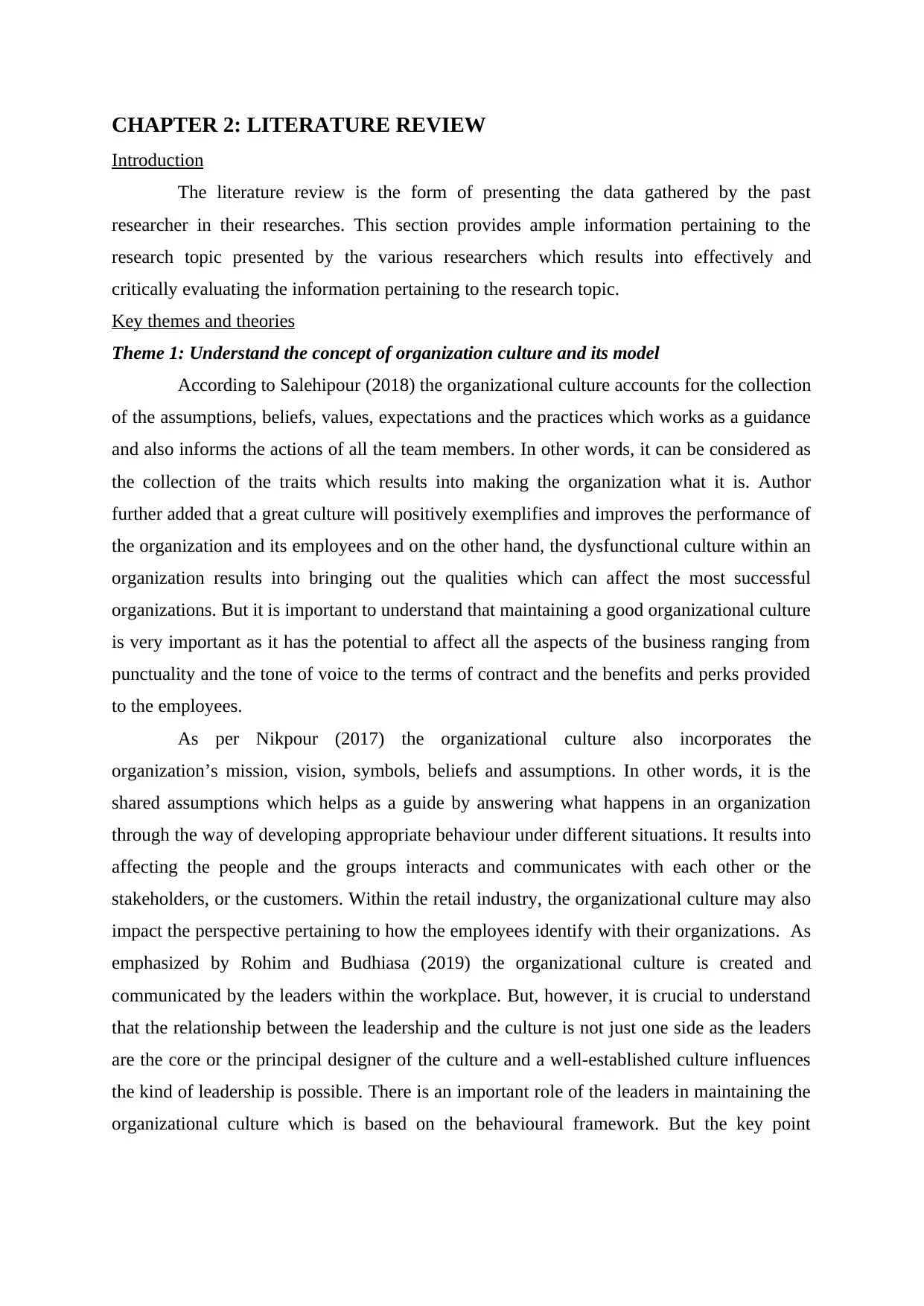
CHAPTER 2: LITERATURE REVIEW
Introduction
The literature review is the form of presenting the data gathered by the past
researcher in their researches. This section provides ample information pertaining to the
research topic presented by the various researchers which results into effectively and
critically evaluating the information pertaining to the research topic.
Key themes and theories
Theme 1: Understand the concept of organization culture and its model
According to Salehipour (2018) the organizational culture accounts for the collection
of the assumptions, beliefs, values, expectations and the practices which works as a guidance
and also informs the actions of all the team members. In other words, it can be considered as
the collection of the traits which results into making the organization what it is. Author
further added that a great culture will positively exemplifies and improves the performance of
the organization and its employees and on the other hand, the dysfunctional culture within an
organization results into bringing out the qualities which can affect the most successful
organizations. But it is important to understand that maintaining a good organizational culture
is very important as it has the potential to affect all the aspects of the business ranging from
punctuality and the tone of voice to the terms of contract and the benefits and perks provided
to the employees.
As per Nikpour (2017) the organizational culture also incorporates the
organization’s mission, vision, symbols, beliefs and assumptions. In other words, it is the
shared assumptions which helps as a guide by answering what happens in an organization
through the way of developing appropriate behaviour under different situations. It results into
affecting the people and the groups interacts and communicates with each other or the
stakeholders, or the customers. Within the retail industry, the organizational culture may also
impact the perspective pertaining to how the employees identify with their organizations. As
emphasized by Rohim and Budhiasa (2019) the organizational culture is created and
communicated by the leaders within the workplace. But, however, it is crucial to understand
that the relationship between the leadership and the culture is not just one side as the leaders
are the core or the principal designer of the culture and a well-established culture influences
the kind of leadership is possible. There is an important role of the leaders in maintaining the
organizational culture which is based on the behavioural framework. But the key point
Introduction
The literature review is the form of presenting the data gathered by the past
researcher in their researches. This section provides ample information pertaining to the
research topic presented by the various researchers which results into effectively and
critically evaluating the information pertaining to the research topic.
Key themes and theories
Theme 1: Understand the concept of organization culture and its model
According to Salehipour (2018) the organizational culture accounts for the collection
of the assumptions, beliefs, values, expectations and the practices which works as a guidance
and also informs the actions of all the team members. In other words, it can be considered as
the collection of the traits which results into making the organization what it is. Author
further added that a great culture will positively exemplifies and improves the performance of
the organization and its employees and on the other hand, the dysfunctional culture within an
organization results into bringing out the qualities which can affect the most successful
organizations. But it is important to understand that maintaining a good organizational culture
is very important as it has the potential to affect all the aspects of the business ranging from
punctuality and the tone of voice to the terms of contract and the benefits and perks provided
to the employees.
As per Nikpour (2017) the organizational culture also incorporates the
organization’s mission, vision, symbols, beliefs and assumptions. In other words, it is the
shared assumptions which helps as a guide by answering what happens in an organization
through the way of developing appropriate behaviour under different situations. It results into
affecting the people and the groups interacts and communicates with each other or the
stakeholders, or the customers. Within the retail industry, the organizational culture may also
impact the perspective pertaining to how the employees identify with their organizations. As
emphasized by Rohim and Budhiasa (2019) the organizational culture is created and
communicated by the leaders within the workplace. But, however, it is crucial to understand
that the relationship between the leadership and the culture is not just one side as the leaders
are the core or the principal designer of the culture and a well-established culture influences
the kind of leadership is possible. There is an important role of the leaders in maintaining the
organizational culture which is based on the behavioural framework. But the key point
⊘ This is a preview!⊘
Do you want full access?
Subscribe today to unlock all pages.

Trusted by 1+ million students worldwide
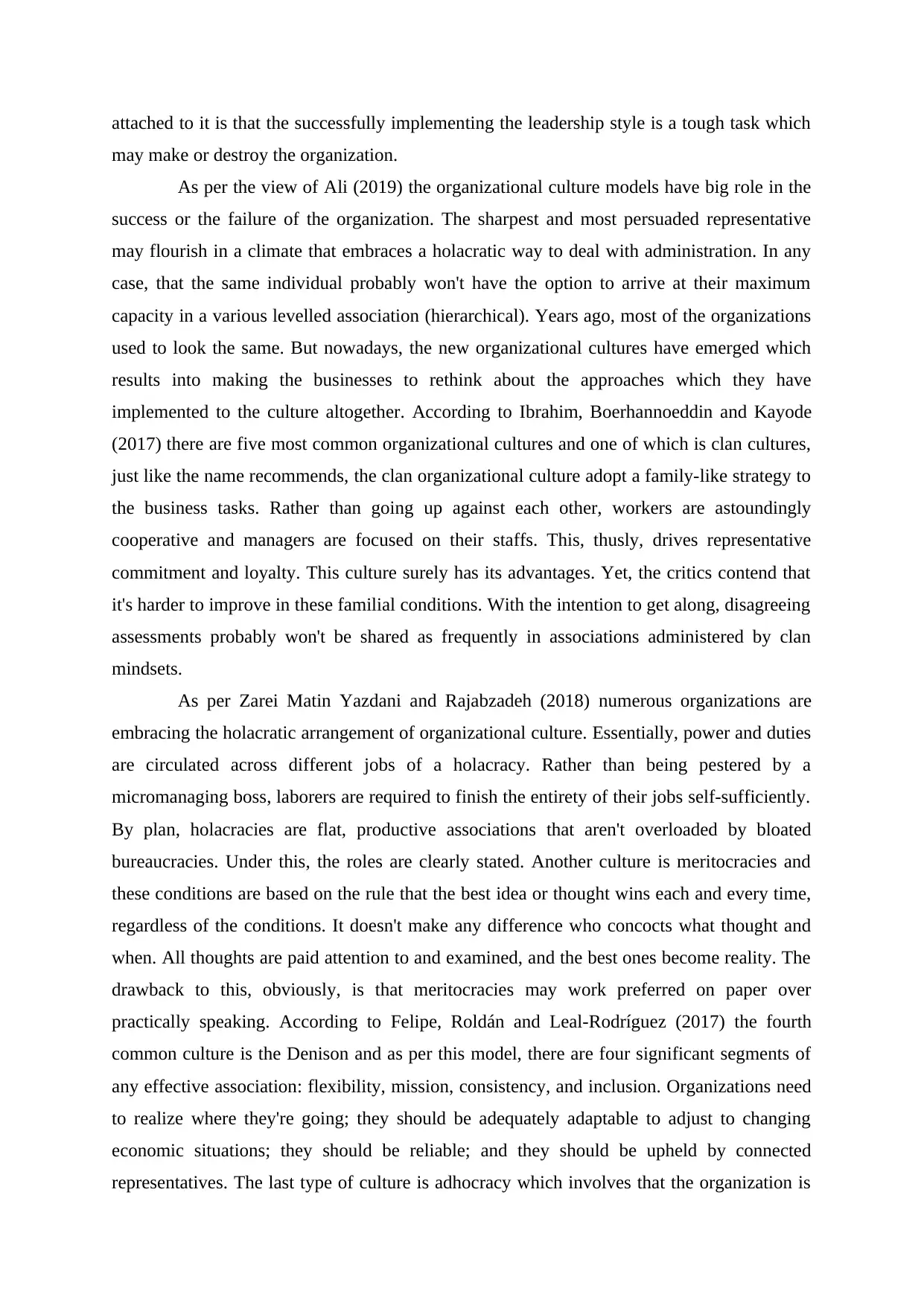
attached to it is that the successfully implementing the leadership style is a tough task which
may make or destroy the organization.
As per the view of Ali (2019) the organizational culture models have big role in the
success or the failure of the organization. The sharpest and most persuaded representative
may flourish in a climate that embraces a holacratic way to deal with administration. In any
case, that the same individual probably won't have the option to arrive at their maximum
capacity in a various levelled association (hierarchical). Years ago, most of the organizations
used to look the same. But nowadays, the new organizational cultures have emerged which
results into making the businesses to rethink about the approaches which they have
implemented to the culture altogether. According to Ibrahim, Boerhannoeddin and Kayode
(2017) there are five most common organizational cultures and one of which is clan cultures,
just like the name recommends, the clan organizational culture adopt a family-like strategy to
the business tasks. Rather than going up against each other, workers are astoundingly
cooperative and managers are focused on their staffs. This, thusly, drives representative
commitment and loyalty. This culture surely has its advantages. Yet, the critics contend that
it's harder to improve in these familial conditions. With the intention to get along, disagreeing
assessments probably won't be shared as frequently in associations administered by clan
mindsets.
As per Zarei Matin Yazdani and Rajabzadeh (2018) numerous organizations are
embracing the holacratic arrangement of organizational culture. Essentially, power and duties
are circulated across different jobs of a holacracy. Rather than being pestered by a
micromanaging boss, laborers are required to finish the entirety of their jobs self-sufficiently.
By plan, holacracies are flat, productive associations that aren't overloaded by bloated
bureaucracies. Under this, the roles are clearly stated. Another culture is meritocracies and
these conditions are based on the rule that the best idea or thought wins each and every time,
regardless of the conditions. It doesn't make any difference who concocts what thought and
when. All thoughts are paid attention to and examined, and the best ones become reality. The
drawback to this, obviously, is that meritocracies may work preferred on paper over
practically speaking. According to Felipe, Roldán and Leal-Rodríguez (2017) the fourth
common culture is the Denison and as per this model, there are four significant segments of
any effective association: flexibility, mission, consistency, and inclusion. Organizations need
to realize where they're going; they should be adequately adaptable to adjust to changing
economic situations; they should be reliable; and they should be upheld by connected
representatives. The last type of culture is adhocracy which involves that the organization is
may make or destroy the organization.
As per the view of Ali (2019) the organizational culture models have big role in the
success or the failure of the organization. The sharpest and most persuaded representative
may flourish in a climate that embraces a holacratic way to deal with administration. In any
case, that the same individual probably won't have the option to arrive at their maximum
capacity in a various levelled association (hierarchical). Years ago, most of the organizations
used to look the same. But nowadays, the new organizational cultures have emerged which
results into making the businesses to rethink about the approaches which they have
implemented to the culture altogether. According to Ibrahim, Boerhannoeddin and Kayode
(2017) there are five most common organizational cultures and one of which is clan cultures,
just like the name recommends, the clan organizational culture adopt a family-like strategy to
the business tasks. Rather than going up against each other, workers are astoundingly
cooperative and managers are focused on their staffs. This, thusly, drives representative
commitment and loyalty. This culture surely has its advantages. Yet, the critics contend that
it's harder to improve in these familial conditions. With the intention to get along, disagreeing
assessments probably won't be shared as frequently in associations administered by clan
mindsets.
As per Zarei Matin Yazdani and Rajabzadeh (2018) numerous organizations are
embracing the holacratic arrangement of organizational culture. Essentially, power and duties
are circulated across different jobs of a holacracy. Rather than being pestered by a
micromanaging boss, laborers are required to finish the entirety of their jobs self-sufficiently.
By plan, holacracies are flat, productive associations that aren't overloaded by bloated
bureaucracies. Under this, the roles are clearly stated. Another culture is meritocracies and
these conditions are based on the rule that the best idea or thought wins each and every time,
regardless of the conditions. It doesn't make any difference who concocts what thought and
when. All thoughts are paid attention to and examined, and the best ones become reality. The
drawback to this, obviously, is that meritocracies may work preferred on paper over
practically speaking. According to Felipe, Roldán and Leal-Rodríguez (2017) the fourth
common culture is the Denison and as per this model, there are four significant segments of
any effective association: flexibility, mission, consistency, and inclusion. Organizations need
to realize where they're going; they should be adequately adaptable to adjust to changing
economic situations; they should be reliable; and they should be upheld by connected
representatives. The last type of culture is adhocracy which involves that the organization is
Paraphrase This Document
Need a fresh take? Get an instant paraphrase of this document with our AI Paraphraser
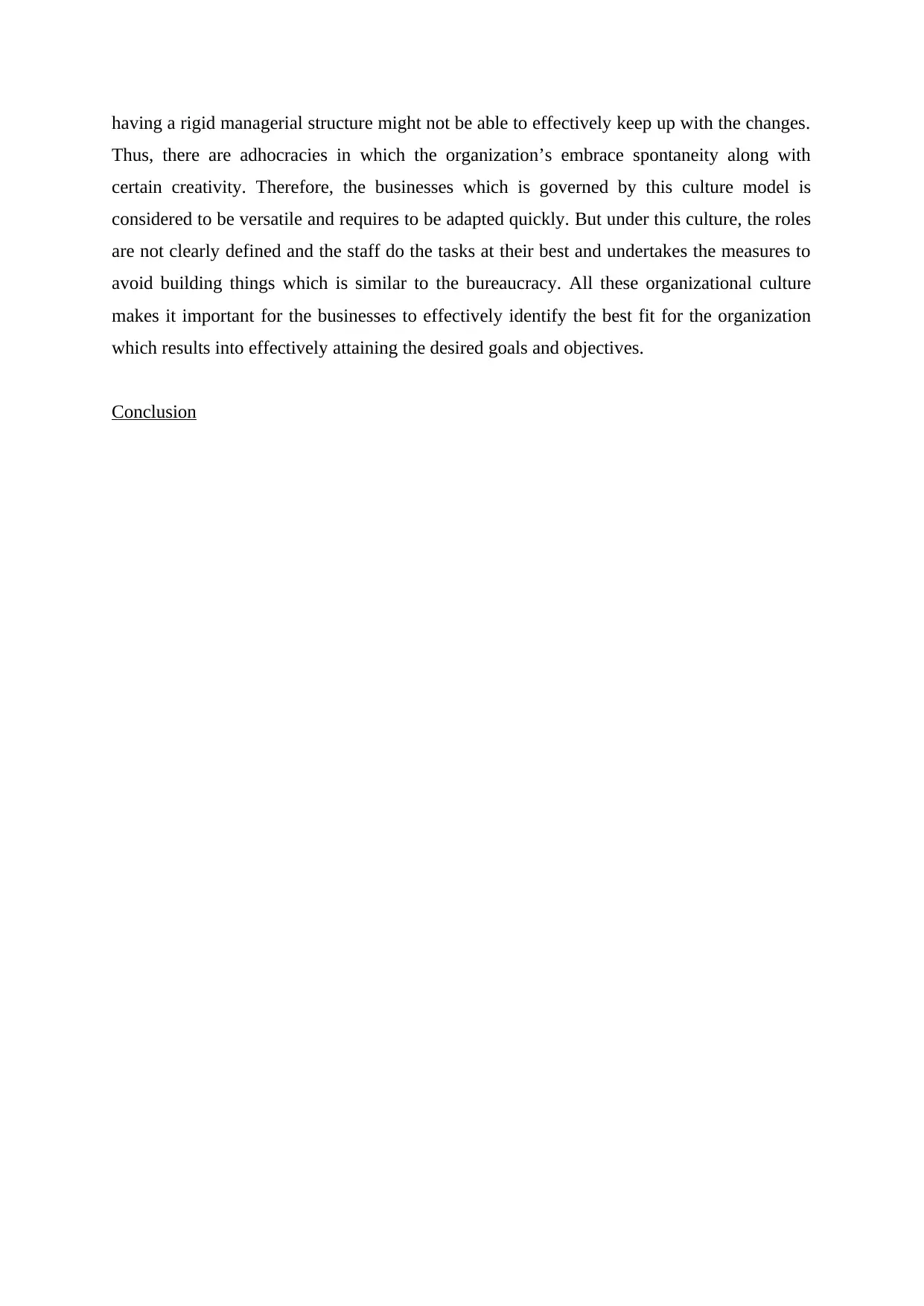
having a rigid managerial structure might not be able to effectively keep up with the changes.
Thus, there are adhocracies in which the organization’s embrace spontaneity along with
certain creativity. Therefore, the businesses which is governed by this culture model is
considered to be versatile and requires to be adapted quickly. But under this culture, the roles
are not clearly defined and the staff do the tasks at their best and undertakes the measures to
avoid building things which is similar to the bureaucracy. All these organizational culture
makes it important for the businesses to effectively identify the best fit for the organization
which results into effectively attaining the desired goals and objectives.
Conclusion
Thus, there are adhocracies in which the organization’s embrace spontaneity along with
certain creativity. Therefore, the businesses which is governed by this culture model is
considered to be versatile and requires to be adapted quickly. But under this culture, the roles
are not clearly defined and the staff do the tasks at their best and undertakes the measures to
avoid building things which is similar to the bureaucracy. All these organizational culture
makes it important for the businesses to effectively identify the best fit for the organization
which results into effectively attaining the desired goals and objectives.
Conclusion
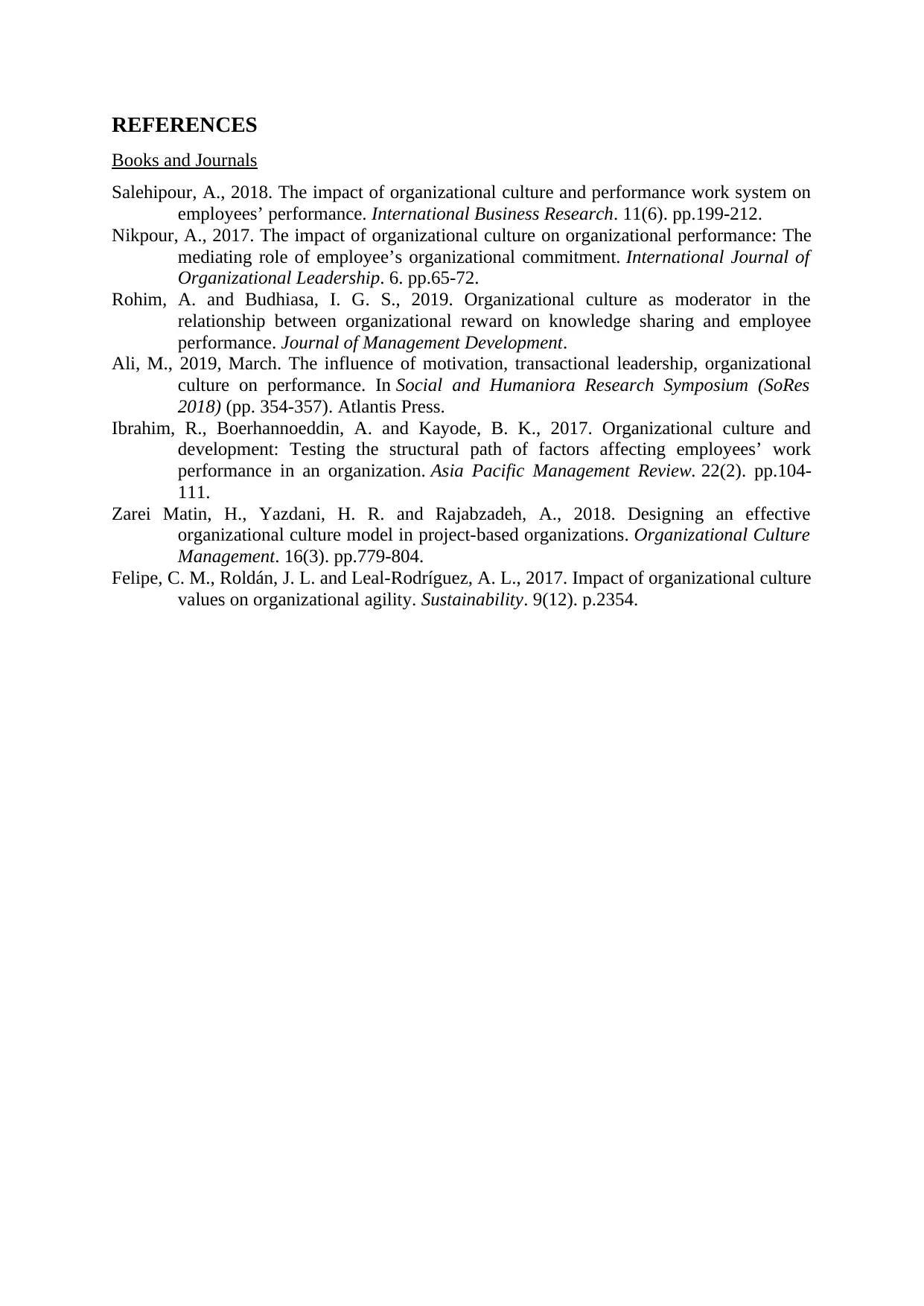
REFERENCES
Books and Journals
Salehipour, A., 2018. The impact of organizational culture and performance work system on
employees’ performance. International Business Research. 11(6). pp.199-212.
Nikpour, A., 2017. The impact of organizational culture on organizational performance: The
mediating role of employee’s organizational commitment. International Journal of
Organizational Leadership. 6. pp.65-72.
Rohim, A. and Budhiasa, I. G. S., 2019. Organizational culture as moderator in the
relationship between organizational reward on knowledge sharing and employee
performance. Journal of Management Development.
Ali, M., 2019, March. The influence of motivation, transactional leadership, organizational
culture on performance. In Social and Humaniora Research Symposium (SoRes
2018) (pp. 354-357). Atlantis Press.
Ibrahim, R., Boerhannoeddin, A. and Kayode, B. K., 2017. Organizational culture and
development: Testing the structural path of factors affecting employees’ work
performance in an organization. Asia Pacific Management Review. 22(2). pp.104-
111.
Zarei Matin, H., Yazdani, H. R. and Rajabzadeh, A., 2018. Designing an effective
organizational culture model in project-based organizations. Organizational Culture
Management. 16(3). pp.779-804.
Felipe, C. M., Roldán, J. L. and Leal-Rodríguez, A. L., 2017. Impact of organizational culture
values on organizational agility. Sustainability. 9(12). p.2354.
Books and Journals
Salehipour, A., 2018. The impact of organizational culture and performance work system on
employees’ performance. International Business Research. 11(6). pp.199-212.
Nikpour, A., 2017. The impact of organizational culture on organizational performance: The
mediating role of employee’s organizational commitment. International Journal of
Organizational Leadership. 6. pp.65-72.
Rohim, A. and Budhiasa, I. G. S., 2019. Organizational culture as moderator in the
relationship between organizational reward on knowledge sharing and employee
performance. Journal of Management Development.
Ali, M., 2019, March. The influence of motivation, transactional leadership, organizational
culture on performance. In Social and Humaniora Research Symposium (SoRes
2018) (pp. 354-357). Atlantis Press.
Ibrahim, R., Boerhannoeddin, A. and Kayode, B. K., 2017. Organizational culture and
development: Testing the structural path of factors affecting employees’ work
performance in an organization. Asia Pacific Management Review. 22(2). pp.104-
111.
Zarei Matin, H., Yazdani, H. R. and Rajabzadeh, A., 2018. Designing an effective
organizational culture model in project-based organizations. Organizational Culture
Management. 16(3). pp.779-804.
Felipe, C. M., Roldán, J. L. and Leal-Rodríguez, A. L., 2017. Impact of organizational culture
values on organizational agility. Sustainability. 9(12). p.2354.
⊘ This is a preview!⊘
Do you want full access?
Subscribe today to unlock all pages.

Trusted by 1+ million students worldwide
1 out of 9
Related Documents
Your All-in-One AI-Powered Toolkit for Academic Success.
+13062052269
info@desklib.com
Available 24*7 on WhatsApp / Email
![[object Object]](/_next/static/media/star-bottom.7253800d.svg)
Unlock your academic potential
Copyright © 2020–2025 A2Z Services. All Rights Reserved. Developed and managed by ZUCOL.




